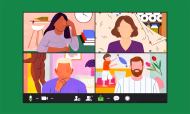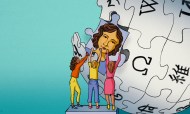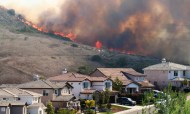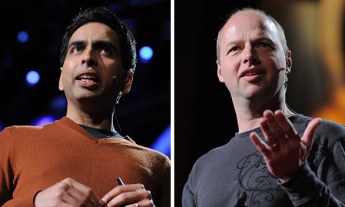When Salman Khan shared his vision for “a free world-class education for anyone anywhere” at TED2011, he turned the education world on its head. As he introduced Khan Academy — a virtual classroom that uses video lessons to create an individualized, self-paced learning experience — his alternative model fueled the nascent dialogue about online education. The conversation only exploded from there.
In the three years since his talk, Khan has doubled down on his efforts to cultivate Khan Academy into the education model of the future. The site now has more than 10 million unique users per month, with five million exercises completed daily. The lessons are available in 29 languages, and are hosted on five fully translated sites. Through collaborations with MIT, the Getty Museum and the MOMA, Khan Academy is focusing its efforts on expanding and deepening its content offerings. It has even partnered with LeBron James, to up its cool factor.
Khan himself has been busy reimagining the education experience. After his talk ignited impassioned dialogue, he wrote a book that digs deeper into his idea — a landscape where teachers work in tandem with technology to foster the best learning environment for each student.
We spoke with Khan about the academy’s incredible growth, and what’s on the horizon for classrooms both physical and virtual. Below, an edited transcript of that conversation.
Khan Academy has seen incredible growth since you spoke in 2011. Where are you focusing your efforts as you expand?
Content coverage is a big thing. We’re making sure that, by next school year, our math experience is a very strong implementation of the Common Core, the math standards adopted by 46 states. Relative to where we were in 2011 when the TED Talk happened, back then we already had reasonable coverage — a scaffold of K-12 math and beyond — but now we’re serious about absolute full coverage of all of the major concepts that one would need to know for the K-12 Common Core, as well as AP Calculus. We’re doing a partnership with the AP tests to make sure that our AP Calculus is fully comprehensive. Since the talk, we’ve dramatically increased our coverage of physics and chemistry, math and history, and we brought on some art historians. Our broader video content has broadened dramatically.
In my TED Talk, I didn’t talk a lot about the use of data and analytics to fine-tune the experience — and that’s something we’re kind of doing all-out as we speak. We probably have 20 experiments on the site about retention, learning, engagement — whatever you want to call it. We have postdocs from Stanford and other places to actually do tests in cognitive science and learning science. That’s a big part of what we’re doing now. We’re also strengthening the personalization piece — we’re using very sophisticated machine learning in the background system to understand what the student likely knows and doesn’t know, and to give recommendations based on that. At the time of the TED Talk, we were going in that direction but it was a much simpler and more basic system. Now it’s really cutting edge.
The other big thing that’s happening is internationalization. It’s something that we’ve been working on for about a year and a half now, but we’ve just launched Spanish Khan Academy, and Brazilian Portuguese Khan Academy, Turkish and French and all the world’s major languages. This is not just redoing or translating the videos, it’s the whole experience — the software, the dashboard.
How have you seen the thinking about education shift since you gave your TED Talk?
The conversation around the classroom of the future really took off. A lot more people are talking about what a classroom should be like. I don’t want to make too much of that — I think people have always been talking about that, and I don’t think it’s the TED talk alone that did it — but I do think it did help catalyze more conversation around what a school should look like, and what its credentials should be.
Since the talk, I published my book, The One World Schoolhouse. I hadn’t even agreed to write a book at the time of the TED Talk, and I think the talk catalyzed what people were interested in and helped it get published. The book pushes the TED talk to a deeper level –it’s also talking about credentialing and higher education.
An interesting element to this conversation is the rise of MOOCS. Where do you see Khan Academy in relation to online university courses?
I think we share a common lineage. I wouldn’t claim that Khan Academy was the first — we kind of grew out of MIT open courseware. But Sebastian Thrun was the first to launch a MOOC — he was apparently in the audience at my TED Talk and he was thinking, “Well, I’m a Stanford professor, I should be able to do this too!” He went off that very next fall and launched the first MOOC. And of course that was followed by Coursera and edX. I think we’re all focused on a free, world-class education for anyone, anywhere. So I think in that way we are completely aligned.
The difference is the implementation approach. I think MOOCS are trying to take a traditional university course model: start on a certain day, have problem sets due, everyone goes together in a synchronous way — it’s a virtual experience of a classroom. You register for a MOOC and you get a credential at the end of it. At Khan Academy, we’ve been trying to go a little more clean slate: if this is someone’s goal, how can they go at their own pace, how can we use exercises and analytics and dashboards to rethink the classroom? So a MOOC is: you’re going to take a course. Khan Academy is anywhere between, “I have a test tomorrow on L’Hôpital’s rule, so let me go get some practice on it,” all the way to, “I am running a calculus class and I want all my students to learn at their own pace with me as their teacher to see where they are so I can see who’s ready for a project or a conversation and if someone’s falling behind I can pair students together.” Khan Academy and MOOCS are taking different approaches to helping people learn.
There has been a lot of debate about the limits of online education. What content do you think works best online and what’s better left to a real-life setting?
I think the ideal is to have both.
Anything that lasts more than 30 seconds — or any explanation — makes sense to have in a video form. Or it could be in a text form and video form, so that students can get it whenever they want and they don’t have to feel judged. They can pause and repeat. Practice and feedback for a large set of classes — especially math and science — can be done really well online. I think it hasn’t been done really well, but it can be done well online if you have large item banks. Before the computer was invented, there was a multibillion-dollar industry of people writing algorithm problems. Why wasn’t there just a shared bank for these things? Now that we have the Internet, you can have these shared banks and you can also have a common way to interface with them and give the teachers analytics and feedback that is really good through software tools.
What that means for the teacher is a much higher value task of mentoring students, motivating students, having conversations with students. To a large degree, this is what’s always been true in humanities class. In a seminar, the professor doesn’t read the textbook or the novel to the students — they do that on their own — and then class time is much more valuable for richer experiences. We’d like to push that one step further with math or science material and allow students to move at their own pace. Because even if I didn’t read the last book in my literature class, I can engage in the next book. But, if I didn’t understand the last three chapters of math, I’m not going to be able to engage on the next one.
What are some surprising ways people are using Khan Academy?
The two that jump out at me: One example is a school in Oakland — Oakland Unity School — which is a charter school that takes students who are several grade levels behind coming out of Oakland City public schools. They’ve achieved dramatic results. The year before they were using Khan Academy, they were in the 50th percentile in California, and then using Khan Academy, they’re approaching the 98th percentile. I can’t imply that’s purely due to Khan Academy because it’s just one of many things they’re doing, but it’s incredible. And what’s so surprising about that is there’s a teacher there and he’s very adamant about using Khan Academy to teach math, but he’s also using math as a pretext for a tool around changing his students’ mindset about having a more active role — to have them take more ownership over their learning. He sees his role as: change their mindset. Once you change their mindset, they become really good students.
The Innova Schools in Peru, which are low-cost private schools for the Peruvian middle class, use Khan Academy as a core part of their math curriculum. And it was surprising because, when they launched, we didn’t even have Spanish Khan Academy but they were using it with students who for the most part did not know English. We started seeing some interesting learning gain. I visited last spring and was wondering how are they doing it, and they just use Google Translate to copy and paste the text and read the subtitles. That was enough to get by. That was a surprisingly good implementation of Khan Academy.
While we’re talking about Khan Academy in other countries, tell me more about the translation effort.
When I gave the talk, we had a very nascent translation effort, and that’s accelerated dramatically. It’s mainly around finding really good partners in different geographies, and the partners do everything from provide funding to the work of the translation, to the vetting to actually implementing it. We’re trying to understand how it can be used in the region’s schools. In Spanish, our main partner is the Carlos Slim Foundation and they do most of the on-the-ground work. In Brazil it’s been the Lemon Foundation that’s been doing most of everything. Our goal is to find groups like that in every major geography.
Are you tailoring content, like history lessons, to specific regions?
Not yet — most of the interest has been around the math content and the science content.
Do you see English lessons as a potential language-learning tool for someone who might want to learn math and English at the same time?
We’ve heard some things like that, but it isn’t really our focus at the moment. An incredible example is a letter I got from this young girl in Mongolia. She has a video that she uses through Khan Academy. I assumed she was middle- or upper-class but turned out that there was a group of engineers from Silicon Valley using their vacation time setting up computer labs in orphanages in Mongolia and she was one of the orphan girls. It was cool by itself that she was using Khan Academy. What’s even cooler is she’s gone off to be one of our main contributors to the Mongolian language of videos so we do have some one-off examples of surprising use case with surprising results who are also helping to translate.
You have a number of exciting partnerships — MIT, the Getty, the MOMA — and LeBron James. How did that one come about?
Yes, MIT, the MOMA and LeBron James. It was one of those strange things where someone emailed us and said, “I work with LeBron James and we’re interested in learning what you’re doing. LeBron wants to help with education and your nonprofit and he wants to do something that really matters.” So we were like, “Yeah, sure.” We met with LeBron and he’s obviously busy, so we tried to come up with something to leverage him but not take up his time. He watched the video about the scale of the sun and was fascinated. And that’s cool — if more kids knew that LeBron was fascinated by it, they would be too. We had a back and forth where LeBron asked a question about science, and then I or someone else tried to answer the question.
Where do you see Khan Academy evolving in the next 2-5 years? What’s the next big step?
The Common Core is a big thing — it’s about Khan Academy trying to fully empower teachers. What we’re doing with the common core is we want this to be a really useful tool that can really help teachers and that they’re really getting the common core materials and having time to work on other things. Hopefully in the next few years, we can really validate the utility of the Khan Academy in all types of classrooms.
I think internationalization may be three to five years out. I imagine that Spanish and Portuguese and Urdu and Hindi and Arabic could be useful for Khan Academy. We haven’t found the right partners for Japanese and Korean yet.
We have a core math experience that’s really interactive and exercise driven, and then there’s our tutorial experience, which includes a curated set of videos and exercises that you might find useful — so that’s our art history experience, our history experience. Hopefully in the next three, four, five years, we can get other areas like physics and chemistry as rich as our core math experience, maybe other things as well — art history, history. And we can leverage the community to do things like writing, and computer science. That’s a big thing that’s happened since the talk was the computer science platform launching — it’s different than the traditional Khan Academy. It’s very hands on and you share what you’ve made and it’s active. Those are the big things. And in terms of reach, who knows where we might get to.
Elizabeth Jacobs is an editorial freelancer at TED.











